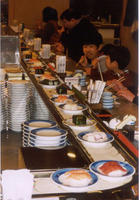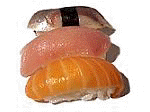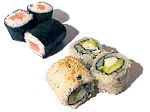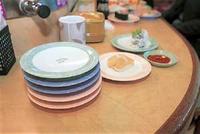First off, please go over to the links section and check out Kelly's updated site. He's been working hard and it looks really nice. The content can be pretty gross, but not as gross as Miggy's site. Lest you think otherwise, I appreciate gross as much as I appreciate exquisite. Miggy mistook me for a troll once, so I'm not linking to his site. Anyhoo, on with the blog...
I'm on a foodblog tear. I think I WILL go get Tempura tomorrow night, so I can get a food blog hat trick. Tonight, I had sushi for dinner. Misawa is a port town in farm country, so all the food, be it from earth or sea, is fresh, fresh, fresh. There are all different levels of sushi places from the economical to the extravagant. Ourselves, we went to Hanakan Sushi, a franchise. Among the Americans in Misawa, Hanakan is known as "Pink Sushi" since the building, the logo, the staff uniforms, are all pink.
Pink Sushi is a Kaiten-zushi restaurant, where the sushi dishes are presented on a conveyor belt.
 You have a little station at which you sit, and it has soy sauce saucers, Waribashi (disposable chopsticks), a box of Gari (pickled ginger for cleansing the palate), tea cups, and Ocha (tea). Drink all the Ocha you want, it is free! Each station at the counter has its own spigot, which dispenses scalding hot water. See?
You have a little station at which you sit, and it has soy sauce saucers, Waribashi (disposable chopsticks), a box of Gari (pickled ginger for cleansing the palate), tea cups, and Ocha (tea). Drink all the Ocha you want, it is free! Each station at the counter has its own spigot, which dispenses scalding hot water. See?
 As the different-colored (pay attention to this part) dishes roll by, you take what you like or you can order dishes which are not available on the belt. There are usually daily specials, usually featuring a seasonal food, in addition to the regular menu items.
As the different-colored (pay attention to this part) dishes roll by, you take what you like or you can order dishes which are not available on the belt. There are usually daily specials, usually featuring a seasonal food, in addition to the regular menu items.
But wait, you Baka Gaijin, you are begetarian--you don't eat fish or chicken or any sort of animal, how can you get sushi? Well, they have Kappa (cucumber) and Kanpyo (gourd) and Takenoko (bamboo), as well as Tamago(an omelette-like affair) and right now, in Misawa, the larger of the two Pink Sushi shops have this amazing pickled eggplant. (I had four plates/eight pieces of it tonight). I also get Anti-Atkins Sushi (they don't call it that, I do), which is corn mixed with a little mayo served on a pat of rice and wrapped with Nori (seaweed) in the Gunkan (warship) style of sushi. Over there to the left is an example of Gunkan Sushi. It contains Ikura (roe) instead of corn salad, but you get the idea, don't you?
Well, they have Kappa (cucumber) and Kanpyo (gourd) and Takenoko (bamboo), as well as Tamago(an omelette-like affair) and right now, in Misawa, the larger of the two Pink Sushi shops have this amazing pickled eggplant. (I had four plates/eight pieces of it tonight). I also get Anti-Atkins Sushi (they don't call it that, I do), which is corn mixed with a little mayo served on a pat of rice and wrapped with Nori (seaweed) in the Gunkan (warship) style of sushi. Over there to the left is an example of Gunkan Sushi. It contains Ikura (roe) instead of corn salad, but you get the idea, don't you?
Ikura, by the way, is one of Sylvia's favorites. She also likes fried Ika (Squid) tentacles. The tentacles are pretty rubbery and require vigorous and somewhat lengthy chewing. I wish I had a picture of Sly with the tentacles hanging out of her mouth, it's pretty funny. What's not funny is when you snort rice out of your nose. In fact, it hurts. A lot. Refrain from laughing at Sly and her tentacles when you have a mouthful of rice.
Speaking of rice, Inari Zushi is something I request often. Inari are pockets of fried tofu,st uffed with rice. The tofu pocket is slightly sweet and sticky and they are oishii (delicious). Sometimes, they sprinkle Goma (sesame seeds) throughout the rice filling, which is great for me, since I am rather fond of sesame. Inari, by the way, is also a Shinto deity, and is the god of rice. His totem animal is the Kitsune (fox). I've seen Wakame (seaweed) chopped up and used in the filling, too, and sometimes Chris has seen Inari with shreds of pork in (I avoid those). I like to stuff the whole Inari in my mouth at once. It makes me look like a chipmunk but for some reason it makes the Inari taste even better.
uffed with rice. The tofu pocket is slightly sweet and sticky and they are oishii (delicious). Sometimes, they sprinkle Goma (sesame seeds) throughout the rice filling, which is great for me, since I am rather fond of sesame. Inari, by the way, is also a Shinto deity, and is the god of rice. His totem animal is the Kitsune (fox). I've seen Wakame (seaweed) chopped up and used in the filling, too, and sometimes Chris has seen Inari with shreds of pork in (I avoid those). I like to stuff the whole Inari in my mouth at once. It makes me look like a chipmunk but for some reason it makes the Inari taste even better.
Chris particularly likes Meguro(Tuna) and Shimisaba (Mackerel) and Salmon. These are often served as Nigiri, which is the raw fish on top of a pat of rice. Most of my veggie sushi are done in this style, although the Kanpyo and Kappa come in the Hosomaki or
this style, although the Kanpyo and Kappa come in the Hosomaki or Norimaki (roll) style. I've never seen the "inside out" rolls served at Pink Sushi or at any of the other places in Japan where I have dined. I did see them at a lot of places back in the United States, though. Chris also digs Pink Sushi's Karaage (fried chicken). One of the first times we went to Pink Sushi, Chris inadvertently tried horsemeat, mistaking it for prosciutto (he won't make that mistake again). The Tohoku region (where we live) is renowned for its horses which are descendants of a herd established by a local nobleman. Beautiful animals and apparently pretty tasty, as well.
Norimaki (roll) style. I've never seen the "inside out" rolls served at Pink Sushi or at any of the other places in Japan where I have dined. I did see them at a lot of places back in the United States, though. Chris also digs Pink Sushi's Karaage (fried chicken). One of the first times we went to Pink Sushi, Chris inadvertently tried horsemeat, mistaking it for prosciutto (he won't make that mistake again). The Tohoku region (where we live) is renowned for its horses which are descendants of a herd established by a local nobleman. Beautiful animals and apparently pretty tasty, as well.
There's always some oddball pieces making the rounds on the conveyor belt, like a tuna-salad Norimaki, a ebi-pizza Nigiri (a piece of boiled shrimp covered with a dot of pizza sauce and melted mozzerella cheese), Kimchee Gunkan, and some mystery rolls, of inscrutable ingredients. At any rate, there's a lot of variety for the price and the price is pretty good, too!
Kaiten-zushi tend to be less expensive than usual sushi-ya, and Pink Sushi is extremely popular with families as a result. Chris and I can eat extraordinarily well for about 18 bucks, and most of the cost is Chris' plates, since my sushi is about 100 yen (or 95 cents or so) for two pieces.
The method of tallying the bill is pretty clever: When you are Ippai Ni (filled up!), you tell the Sushi Chef, "Oiso onegaishemasu" (I'm finished, please) and she calls the cashier to d o the bill because traditionally, sushi chefs never handle money (it's dirty and it distracts from their main duty of making the sushi). Did you pay attention at the beginning of the entry, when I told you to? Basically, the number of plates is counted to determine the cost. Before the lady (most of the employees at Pink Sushi are women) counts up the plates, you can tell her "Issho Ni" (all together) or Betsu Betsu (separate) for the check(s). She then counts the dishes, ticks off the appropriate boxes on the check slip, recounts the plates to verify her results and hands you the check with a thank you and a bow. You take the check up front to pay, because in restaurants in Japan, you don't pay at the table--and you don't tip, either. I do however like to tell the Sushi Chef "Arigato, oshiikata deshita" (Thank you, it was delicious). It always makes them smile.
o the bill because traditionally, sushi chefs never handle money (it's dirty and it distracts from their main duty of making the sushi). Did you pay attention at the beginning of the entry, when I told you to? Basically, the number of plates is counted to determine the cost. Before the lady (most of the employees at Pink Sushi are women) counts up the plates, you can tell her "Issho Ni" (all together) or Betsu Betsu (separate) for the check(s). She then counts the dishes, ticks off the appropriate boxes on the check slip, recounts the plates to verify her results and hands you the check with a thank you and a bow. You take the check up front to pay, because in restaurants in Japan, you don't pay at the table--and you don't tip, either. I do however like to tell the Sushi Chef "Arigato, oshiikata deshita" (Thank you, it was delicious). It always makes them smile.
I'm on a foodblog tear. I think I WILL go get Tempura tomorrow night, so I can get a food blog hat trick. Tonight, I had sushi for dinner. Misawa is a port town in farm country, so all the food, be it from earth or sea, is fresh, fresh, fresh. There are all different levels of sushi places from the economical to the extravagant. Ourselves, we went to Hanakan Sushi, a franchise. Among the Americans in Misawa, Hanakan is known as "Pink Sushi" since the building, the logo, the staff uniforms, are all pink.
Pink Sushi is a Kaiten-zushi restaurant, where the sushi dishes are presented on a conveyor belt.
 You have a little station at which you sit, and it has soy sauce saucers, Waribashi (disposable chopsticks), a box of Gari (pickled ginger for cleansing the palate), tea cups, and Ocha (tea). Drink all the Ocha you want, it is free! Each station at the counter has its own spigot, which dispenses scalding hot water. See?
You have a little station at which you sit, and it has soy sauce saucers, Waribashi (disposable chopsticks), a box of Gari (pickled ginger for cleansing the palate), tea cups, and Ocha (tea). Drink all the Ocha you want, it is free! Each station at the counter has its own spigot, which dispenses scalding hot water. See? As the different-colored (pay attention to this part) dishes roll by, you take what you like or you can order dishes which are not available on the belt. There are usually daily specials, usually featuring a seasonal food, in addition to the regular menu items.
As the different-colored (pay attention to this part) dishes roll by, you take what you like or you can order dishes which are not available on the belt. There are usually daily specials, usually featuring a seasonal food, in addition to the regular menu items.But wait, you Baka Gaijin, you are begetarian--you don't eat fish or chicken or any sort of animal, how can you get sushi?
 Well, they have Kappa (cucumber) and Kanpyo (gourd) and Takenoko (bamboo), as well as Tamago(an omelette-like affair) and right now, in Misawa, the larger of the two Pink Sushi shops have this amazing pickled eggplant. (I had four plates/eight pieces of it tonight). I also get Anti-Atkins Sushi (they don't call it that, I do), which is corn mixed with a little mayo served on a pat of rice and wrapped with Nori (seaweed) in the Gunkan (warship) style of sushi. Over there to the left is an example of Gunkan Sushi. It contains Ikura (roe) instead of corn salad, but you get the idea, don't you?
Well, they have Kappa (cucumber) and Kanpyo (gourd) and Takenoko (bamboo), as well as Tamago(an omelette-like affair) and right now, in Misawa, the larger of the two Pink Sushi shops have this amazing pickled eggplant. (I had four plates/eight pieces of it tonight). I also get Anti-Atkins Sushi (they don't call it that, I do), which is corn mixed with a little mayo served on a pat of rice and wrapped with Nori (seaweed) in the Gunkan (warship) style of sushi. Over there to the left is an example of Gunkan Sushi. It contains Ikura (roe) instead of corn salad, but you get the idea, don't you?Ikura, by the way, is one of Sylvia's favorites. She also likes fried Ika (Squid) tentacles. The tentacles are pretty rubbery and require vigorous and somewhat lengthy chewing. I wish I had a picture of Sly with the tentacles hanging out of her mouth, it's pretty funny. What's not funny is when you snort rice out of your nose. In fact, it hurts. A lot. Refrain from laughing at Sly and her tentacles when you have a mouthful of rice.
Speaking of rice, Inari Zushi is something I request often. Inari are pockets of fried tofu,st
 uffed with rice. The tofu pocket is slightly sweet and sticky and they are oishii (delicious). Sometimes, they sprinkle Goma (sesame seeds) throughout the rice filling, which is great for me, since I am rather fond of sesame. Inari, by the way, is also a Shinto deity, and is the god of rice. His totem animal is the Kitsune (fox). I've seen Wakame (seaweed) chopped up and used in the filling, too, and sometimes Chris has seen Inari with shreds of pork in (I avoid those). I like to stuff the whole Inari in my mouth at once. It makes me look like a chipmunk but for some reason it makes the Inari taste even better.
uffed with rice. The tofu pocket is slightly sweet and sticky and they are oishii (delicious). Sometimes, they sprinkle Goma (sesame seeds) throughout the rice filling, which is great for me, since I am rather fond of sesame. Inari, by the way, is also a Shinto deity, and is the god of rice. His totem animal is the Kitsune (fox). I've seen Wakame (seaweed) chopped up and used in the filling, too, and sometimes Chris has seen Inari with shreds of pork in (I avoid those). I like to stuff the whole Inari in my mouth at once. It makes me look like a chipmunk but for some reason it makes the Inari taste even better.Chris particularly likes Meguro(Tuna) and Shimisaba (Mackerel) and Salmon. These are often served as Nigiri, which is the raw fish on top of a pat of rice. Most of my veggie sushi are done in
 this style, although the Kanpyo and Kappa come in the Hosomaki or
this style, although the Kanpyo and Kappa come in the Hosomaki or Norimaki (roll) style. I've never seen the "inside out" rolls served at Pink Sushi or at any of the other places in Japan where I have dined. I did see them at a lot of places back in the United States, though. Chris also digs Pink Sushi's Karaage (fried chicken). One of the first times we went to Pink Sushi, Chris inadvertently tried horsemeat, mistaking it for prosciutto (he won't make that mistake again). The Tohoku region (where we live) is renowned for its horses which are descendants of a herd established by a local nobleman. Beautiful animals and apparently pretty tasty, as well.
Norimaki (roll) style. I've never seen the "inside out" rolls served at Pink Sushi or at any of the other places in Japan where I have dined. I did see them at a lot of places back in the United States, though. Chris also digs Pink Sushi's Karaage (fried chicken). One of the first times we went to Pink Sushi, Chris inadvertently tried horsemeat, mistaking it for prosciutto (he won't make that mistake again). The Tohoku region (where we live) is renowned for its horses which are descendants of a herd established by a local nobleman. Beautiful animals and apparently pretty tasty, as well.There's always some oddball pieces making the rounds on the conveyor belt, like a tuna-salad Norimaki, a ebi-pizza Nigiri (a piece of boiled shrimp covered with a dot of pizza sauce and melted mozzerella cheese), Kimchee Gunkan, and some mystery rolls, of inscrutable ingredients. At any rate, there's a lot of variety for the price and the price is pretty good, too!
Kaiten-zushi tend to be less expensive than usual sushi-ya, and Pink Sushi is extremely popular with families as a result. Chris and I can eat extraordinarily well for about 18 bucks, and most of the cost is Chris' plates, since my sushi is about 100 yen (or 95 cents or so) for two pieces.
The method of tallying the bill is pretty clever: When you are Ippai Ni (filled up!), you tell the Sushi Chef, "Oiso onegaishemasu" (I'm finished, please) and she calls the cashier to d
 o the bill because traditionally, sushi chefs never handle money (it's dirty and it distracts from their main duty of making the sushi). Did you pay attention at the beginning of the entry, when I told you to? Basically, the number of plates is counted to determine the cost. Before the lady (most of the employees at Pink Sushi are women) counts up the plates, you can tell her "Issho Ni" (all together) or Betsu Betsu (separate) for the check(s). She then counts the dishes, ticks off the appropriate boxes on the check slip, recounts the plates to verify her results and hands you the check with a thank you and a bow. You take the check up front to pay, because in restaurants in Japan, you don't pay at the table--and you don't tip, either. I do however like to tell the Sushi Chef "Arigato, oshiikata deshita" (Thank you, it was delicious). It always makes them smile.
o the bill because traditionally, sushi chefs never handle money (it's dirty and it distracts from their main duty of making the sushi). Did you pay attention at the beginning of the entry, when I told you to? Basically, the number of plates is counted to determine the cost. Before the lady (most of the employees at Pink Sushi are women) counts up the plates, you can tell her "Issho Ni" (all together) or Betsu Betsu (separate) for the check(s). She then counts the dishes, ticks off the appropriate boxes on the check slip, recounts the plates to verify her results and hands you the check with a thank you and a bow. You take the check up front to pay, because in restaurants in Japan, you don't pay at the table--and you don't tip, either. I do however like to tell the Sushi Chef "Arigato, oshiikata deshita" (Thank you, it was delicious). It always makes them smile.
No comments:
Post a Comment